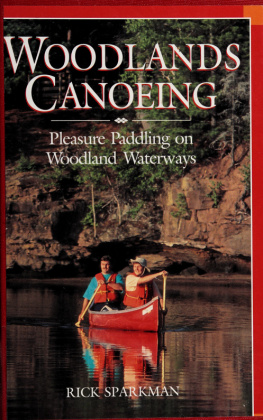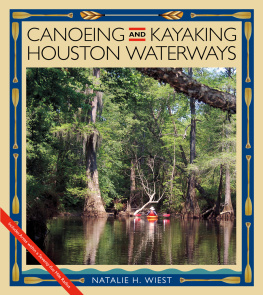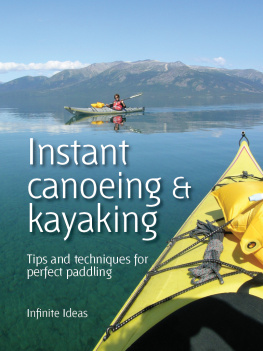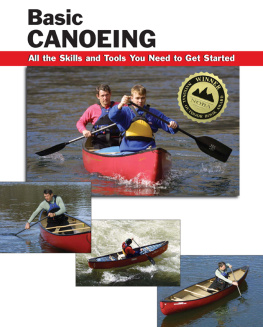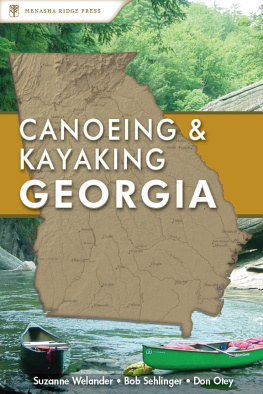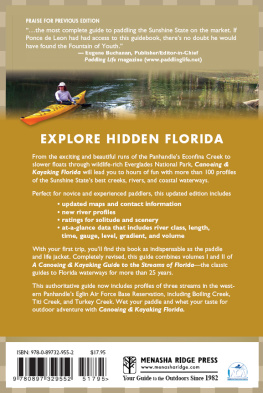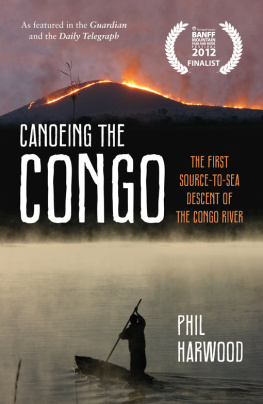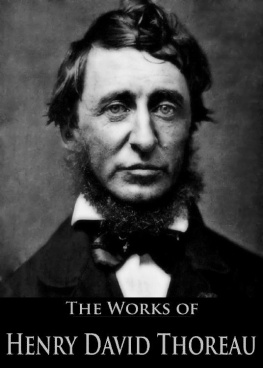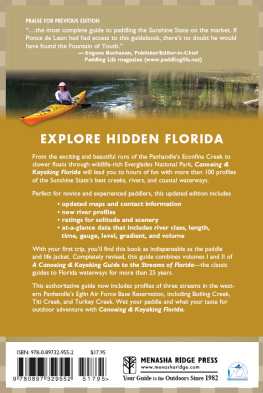
Woodlands canoeing : pleasure paddling on woodland waterways
Sparkman, Rick, 1944
This book was produced in EPUB format by the Internet Archive.
The book pages were scanned and converted to EPUB format automatically. This process relies on optical character recognition, and is somewhat susceptible to errors. The book may not offer the correct reading sequence, and there may be weird characters, non-words, and incorrect guesses at structure. Some page numbers and headers or footers may remain from the scanned page. The process which identifies images might have found stray marks on the page which are not actually images from the book. The hidden page numbering which may be available to your ereader corresponds to the numbered pages in the print edition, but is not an exact match; page numbers will increment at the same rate as the corresponding print edition, but we may have started numbering before the print book's visible page numbers. The Internet Archive is working to improve the scanning process and resulting books, but in the meantime, we hope that this book will be useful to you.
The Internet Archive was founded in 1996 to build an Internet library and to promote universal access to all knowledge. The Archive's purposes include offering permanent access for researchers, historians, scholars, people with disabilities, and the general public to historical collections that exist in digital format. The Internet Archive includes texts, audio, moving images, and software as well as archived web pages, and provides specialized services for information access for the blind and other persons with disabilities.
Created with abbyy2epub (v.1.7.2)
Pleasure Paddling on Woodland Waterways
RICK SPARKMAN
Woodlands Canoeing
Digitized by the Internet Archive in 2019 with funding from Kahle/Austin Foundation
https://archive.org/details/woodlandscanoeinOOOOspar
Woodlands
Canoeing
Pleasure Paddling on Woodland Waterways
K U
RICK SPARKMAN
Rick Sparkman, 1998.
All rights reserved. No part of this work may be reproduced or used in any form or by any means, electronic or mechanical, including photocopying, recording, or any retrieval system, without the prior written permission of the publisher. Any requests for photocopying of any part of this book should be directed in writing to the Canadian Copyright Licensing Agency.
Published by Goose Lane Editions with the assistance of the Canada Council, the Department of Canadian Heritage, and the New Brunswick Department of Municipalities, Culture and Housing, 1998.
Edited by Laurel Boone.
Cover and book design by Ryan Astle.
Printed in Canada by Transcontinental Printing Inc.
10 987654321
Canadian Cataloguing in Publication Data
Sparkman, Rick, 1944Woodlands canoeing ISBN 0-86492-234-5
1. Canoes and Canoeing. I. Title.
GV783.S62 1998 797.1*22 C98-950066-7
Goose Lane Editions 469 King Street Fredericton, New Brunswick CANADA E3B 1E5
This book is dedicated to the memory of my mother, Janet Waterbary Sparkman.
Acknowledgements
Woodlands Canoeing would not have been possible without the support and understanding ot my wife, Jan Sparkman. Most of the events recounted in this book occurred while I was paddling with Jan, with our children Danny and Katy, or with the other Fat Boys, Danny, Dave Sagorka, and Patrick Murphy.
Words alone are inadequate to describe canoeing and camping. Drawings are by Peter Matheson. Photographs are by Peter Hope (PH), Clas Larsson (CL), Karen Coldwell Newton (KCN), and myself (RMS), with an archival photo from the Provincial Archives of New Brunswick (PANB).
Scott Hennigar, an outdoor skills instructor at Acadia University, and three of his students, Adam Kilcollins, Alexis Currer, and Casey Gallagher, gave up their time to model for photographs. Special thanks to Alexis and Casey for floating in the cold October water long enough for Clas to shoot the canoe rescue sequences.
My career as an outdoor writer would have been stillborn had not Jim Gourlay, editor of Eastern Woods and Waters, encouraged and ultimately published some of my early efforts. Portions of this book have appeared in different form in his magazine.
Much of the credit for the finished book must go to my editor, Laurel Boone, who pounded the rough edges off my initial manuscript. Finally, I would like to thank Julie Scriver, Susanne Alexander, Ryan Astle, and all the people at Goose Lane for turning the finished manuscript into a book.
Contents
Acknowledgements 6
Introduction 9
1. ORIGINS OF THE MODERN CANOE 13
2. CANOES AND PADDLES 19
Canoes 19
Paddles 29
Carving Your Own Paddle 32
3. CANOEING EQUIPMENT 35
For the Canoe 35
For the Canoeist 39
Other Personal Equipment 47
4. TANDEM PADDLING 49
Four Strokes That Will Get You Across a Lake 51
More Strokes for Versatility 59
Keeping on Course 61
Rescues 63
5. SOLO PADDLING 66
Solo Canoes 66
Paddling Position 70
Some New Strokes 71
6. CANOEING WITHOUT A PADDLE 76
Poles 76
Learning to Pole 79
Lining 83
7. THE PORTAGE TRAIL 86
Carrying Your Canoe 86
Carrying Your Gear 89
8. CANOEING WITH KIDS 94
9. DRY CAMPS 102
Tarps 104
Tents 108
10. FIRE AND FOOD 117
Building a Good Fire 117
Cooking on a Fire 121
Cooking on a Stove 124
Miscellaneous Good Advice 125
11. MOVING WATER 128
Assessing Your Route 128
Handling Your Canoe 132
12. CANOEING AROUND THE CALENDAR 139
Fall Canoeing 139
Winter Canoeing 143
Canoeing From Ice Out Through Summer 146
13. NOT ROUGHING IT 149
Bibliography 154
Index to Illustrations
Introduction
I learned to paddle a long time after I thought I was an accomplished canoeist. This got me into a little bit ol trouble when I moved to Nova Scotia. Canoeists go through three stages: knowing they do not know how, thinking they know how, and knowing what they know and don t know. The second stage is the one which causes the problems.
I thought I learned to paddle in Texas. It is a great state: oil wells, huge ranches, and a long tradition ol cowboys on horseback. Canoes, however, are irrelevant. Most of the rivers can be forded and they never were used for transportation. I was taught the J stroke. Everything else was wrong. I ran some rapids which I thought were really something, but looking back, I realize they were mostly straight shots.
I dumped lots of times, but the water was always warm; only a Texan thinks 60 water is cold.
All would have been well had we stayed in Texas, but we moved to Nova Scotia and bought a canoe. I did, after all, know how to paddle. My wife, Jan, and I took a long weekend trip in Kejimkujik National Park our first spring. The canoe was heavy, so we started running rapids instead of taking portages. I was, after all, an experienced white water paddler. We made the hrst set ot rapids with luck or perhaps divine intervention the Lord does look after fools on occasion. We hit a rock and capsized in the second set of rapids even the Lords patience has limits. In the end, no great harm was done. We lost a wool shirt, a hat, and a good paddle, and ruined a pair of binoculars, but it could have been a lot worse. The good news was that I got out of stage two. I still did not know how to paddle, but at least I knew it.
Next page
